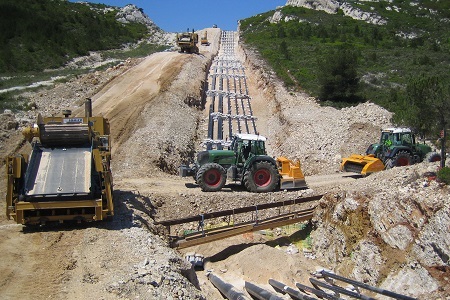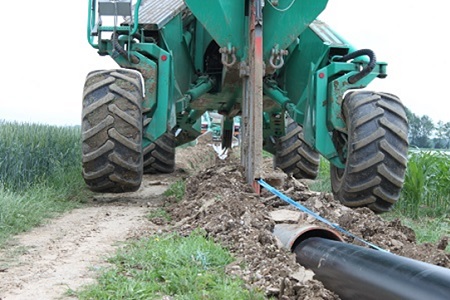Pipe-laying methods
Pipes from Mannesmann Line Pipe can be laid using a variety of methods. Depending on the method, we use Materials and Coatings that possess the necessary fracture resistance and shear strength.
Open-trench pipe-laying

Suitable for all pipe diameters, open-trench pipe-laying is the most common method.
To start with, a trench is excavated along the planned pipeline route. If the in-situ soil does not offer a suitable pipe bed, the trench is deepened and bedded. The pipes can then be lowered into the trench as a welded pipe string.
Plowing

Plowing is a particularly eco-friendly technique, which can be used for pipes up to DN 600, depending on the type of soil, pipe string length and pulling force involved.
By means of a steel rope winch, a special tractor pulls the pipe-laying plow through the soil. The share, which is adjusted to the pipe-laying level plows a furrow into the soil through which the pipe string is pulled in. The displaced soil immediately deposits itself on the pipe string. This makes the process particularly fast, while reducing the impact on the land to an absolute minimum.
Horizontal flush drilling

The horizontal flush drilling technique is used in trenchless pipeline construction and is particularly suitable for pipe-laying in densely built-up urban areas or for crossings underneath water or buildings. The pilot hole is drilled along a two- or three-dimensionally curved line between the entry point (in front of the drill) and an exit point (on the opposite side of the obstacle to be crossed under). The in-situ soil is loosened by a drill head at the front end of the drill string. In the second step in controlled horizontal drilling, the pilot hole is widened. Finally, the pipe string is pulled in from the exit point into the widened borehole.
Offshore pipe-laying on the sea bed poses its own challenges, especially in very deep water. Three methods have established themselves: S-Lay, J-Lay and R-Lay.
J-lay process

The J-lay process is particularly well-suited for pipe-laying in very deep water.
The process uses a pipe-laying vessel with a tower in which the individual pipes are welded to a string, followed by testing and field coating. In a close to vertical position, the finished string is then lowered into the water, while the vessel moves ahead at a slow speed. The characteristic J-shape is created as the pipe string is laid, following a 90 degree curve from a vertical position to the horizontal end position on the sea bed.
S-lay process

The S-lay process is used for pipe-laying at low to medium water depths.
The pipes are welded together on a pipe-laying vessel, followed by final inspection in the form of X-ray testing, and field coating of the joint areas. The pipe string is then pushed off the stern of the vessel and lowered into the water via a stinger. The S-shape eponymous for the process forms as more pipe is welded to the string and eased off the vessel. Between the horizontal welding line onboard the vessel and the seafloor, the pipe segment floating in the water follows a curve that is comparable to a mathematical sigmoid function.
R-lay process

In the R-lay or reel lay process, the pipeline is not welded aboard the vessel but on land, and then wound onto a reel on the vessel. The decisive advantage of this method is that the pipes are joined onshore and thus independently of marine environmental influences, and pipeline production and pipe-laying can be carried out separately. This means when the vessel has laid one pipeline string it can be supplied with a new pipe reel while still offshore. Compared to the J-lay and S-lay processes, the actual time window for pipe-laying can be significantly reduced for added cost economies. However, this advantage comes at the price of high mechanical loads on the pipes generated as the string is spooled on and off the reel. Due to the high requirements involved, this pipe-laying process is currently only used for small to medium pipe diameters.

